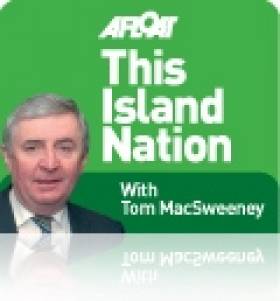Displaying items by tag: Round Ireland Yacht Race
Round Ireland Race Ties the Knot in Dun Laoghaire to Boost Race Numbers
#roundireland – Round Ireland race organisers have increased the maximum race entry to 100 yachts following what has been deemed 'an historic expansion' of the Round Ireland Yacht Race that will facilitate yachts of all sizes taking part, it was announced this evening in Dun Laoghaire.
As previously reported by Afloat.ie in October, Wicklow Sailing Club, which organises the race, has linked up with the Royal Irish Yacht Club to provide full pre-race management facilities in Dún Laoghaire for the larger yachts which are unable to berth in Wicklow Port. Through the introduction of a fully-equipped shore base in Dún Laoghaire, larger boats can now berth and enjoy full pre-race facilities in advance of the Race departure from Wicklow.
The Round Ireland Yacht Race is now in its 34th year and is Ireland's premier offshore sailing race attracting entrants from across Europe and as far afield as Russia, the USA and New Zealand. It will depart Wicklow on Sunday 28th June 2014 at 2.00 pm
There will be no changes to the Race itself, other than increasing the maximum number of entries from 75 to 100 yachts. Wicklow Sailing Club will continue to run the race under the auspices of the Royal Ocean Racing Club and the Race will start and finish in Wicklow.
Organisers at Wicklow Sailing Club expect that this landmark expansion of the Round Ireland through the new association with the Royal Irish Yacht Club is set to give the Race a significantly higher international profile and attract the attention of the larger, ocean racing, fleet.
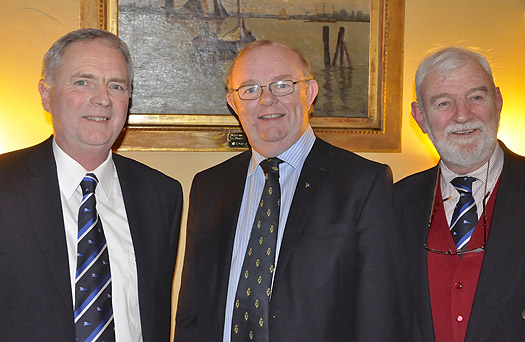
Peter Shearer, Commodore Wicklow Sailing Club, Paddy McSwiney, Commodore Royal Irish Yacht Club, and Theo Phelan, Race Organiser at the launch of the 2014 Round Ireland Yacht Race at the Royal Irish Yacht Club in Dún Laoghaire.

Theo Phelan, Race Organiser , Paddy McSwiney, Commodore Royal Irish Yacht Club, and Sadie Phelan President Wicklow Sailing Club
Race Organiser, Theo Phelan:
"Discussions on expanding the Race have been ongoing for some time arising from expressions of interest from owners of the larger offshore racing yachts seeking entry conditions to our race. Internationally, completing the race is considered a significant feat as the race is one of the most gruelling and challenging sailing competitions in the yacht racing calendar.
"The course, starting and finishing in Wicklow, brings entrants through widely different sea types and coastlines, from the Atlantic ocean to the more sheltered Irish Sea, with difficult tidal gates, particularly around the North Eastern coast and navigational challenges requiring day and night tactical decisions at every change of forecast."
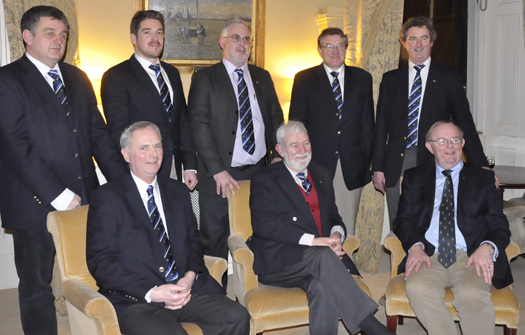
Round Ireland Race committee: (back row) David Ryan, Kevin Johnson, John Harte, John Johnson and Charlie Kavanagh (front) Peter Shearer, Commodore Wicklow Sailing Club, Theo Phelan, Race Organiser and Paddy McSwiney Commodore Royal Irish
Whilst 2014 could see an increase in larger yachts entering the Round Ireland, organisers say that the changes introduced to the management format this year should attract a significantly greater interest in entries for 2016 and subsequent events:
"Huge planning goes into preparing for this race as there are very strict qualifying criteria for crew, yachts and equipment. Knowledge of medical response, survival at sea certificates and a minimum of 300 nautical mile offshore experience are basic to entry as both crew and yacht need to be prepared for all conditions. In 1994 for example, there were 17 retirals from the Race arising from adverse weather and equipment failure. A year's planning to participate in this race would not be unusual and already there will be skippers of larger yachts putting plans in place for 2016."
The Round Ireland Yacht Race is the only RORC race based in Ireland. It is regarded as equivalent in terms of rating points to the Fastnet Race, the classic offshore race, which runs in alternate years to the Round Ireland.
In a final comment the Commodore of Wicklow Sailing Club, Peter Shearer, stated: "The endorsement of the Royal Ocean Racing Club, the largest yacht racing organisation in the world, together with the stated support of the Irish Sailing Association for our new venture bodes well for the forthcoming event in 2014 and for our endeavour to develop the full potential of the Round Ireland Yacht Race."

John Sinnott, president Wicklow Town and District Chamber of Commerce with Dutch Sailing guests Linda and Ronald Koelink
#rdirl – The world's largest yachts will be able to contest the Round Ireland offshore race in June thanks to a new formal arrangement drawn up last month between race organiser's Wicklow Sailing Club (WSC) and the Royal Irish Yacht Club (RIYC) in Dun Laoghaire.
The new arrangements will see entries berthed at the RIYC in Dun Laoghaire harbour for scrutineering prior to the biennial 704–mile race start off Wicklow harbour on June 28th.
Larger boats have been unable to berth in the confines of Wicklow harbour, a factor WSC believes has restricted the growth of the Round Ireland fleet. 'It means we can now encourage larger boats that have shown an interest in competing but we have been unable to cater for in Wicklow' harbour, WSC Commodore Peter Shearer told Afloat.ie.
It is understood WSC has entered in to a formal agreement with RIYC for the provision of services prior to the race at Dun Laoghaire, a harbour that can take yachts of any size.
Round Ireland Yacht Race 2014 Start Date & Time is 2pm, Sat, June 28th
#rdirl – The 2014 Round Ireland Yacht Race, a highlight of the Irish summer sailing season starts from at 2pm on Saturday, June 28th 2014. A full Round Ireland notice of race has been published here.
#roundireland – An amazing last stretch performance from Inis Mor has resulted in a probable IRC overall victory in the 2012 Round Ireland Race.
Tonnerre de Breskens has been in the clubhouse for the last 12 or so hours, setting a corrected time target of 4 days, 18 hours and 20 minutes. As the wind veered to the south, turning the final stretch into an uphill slog, it looked increasingly like the Dutchmen were home and hosed, particularly as Inis Mor was battling a foul tide in her approach to Dublin Bay. However, smart navigation, tacking towards the shore from the nose of Howth and seawards when off the Muglins just as the ebb started, enabled the resilient Frenchmen to make good progress hard on the wind down the Wicklow coast and to cross the line with only minutes to spare after 4 and a half days at sea.
While most of the fleet is still at sea, it seems unlikely, given the weather conditions that a winner can emerge from the pack.
There will be some party in Wicklow tonight!
#islandnation – The FISH IRELAND Exhibition in Killybegs, the Volvo Race in Galway, the Round Ireland Race at Wicklow, commemorating an Arctic hero in Courtmacsherry and where is the summer for sailing? That's quite a mix of maritime material for one week. At least the Volvo is generating more attention to the marine scene in the general media. It is a regrettable that the same attention is not continued throughout the year.
WICKLOW - FISH, YACHTS AND DENNIS NOONAN
Looking out the window of the Race Office perched high above the quay wall at Wicklow, Dennis Noonan recalled his days of sailing Enterprise dinghies at Baltimore in West Cork:
"They challenged your ability. A mistake at a gybe mark and you could end up in the water. You needed to concentrate, but they were a great way to learn sailing," and he chuckled at the memory, then pointed at the cruisers rafted up at the quayside, tugging at their moorings, seeming anxious to get away: "Offshore racing is a different type of sailing, but no less challenging when you take on the coast of Ireland, no matter what the size of the boat."
Dennis is the doyen of the Round Ireland Race which he was describing to me.
"I've stepped back a bit now," he said, waving at the busy office team putting the final arrangements in place for the start of the race when we talked on the evening before the start. The following day he sent 37 yachts off on their 704-mile voyage. "I have to live by the sea," he told me.
Sailing needs determined people like Dennis who, from his time as a boat builder, continues to build lovely model boats.
MORE FISHING BOATS AT WICKLOW
I noted the number of inshore fishing boats tied up at the quayside in Wicklow, as I am sure crews on the yachts gathered for the Round Ireland start also did. It seems that there is good whelk fishing off Wicklow which has attracted the boats and that the port provides better landing facilities than Arklow which had been the dominant fishing port on the Wicklow coastline.
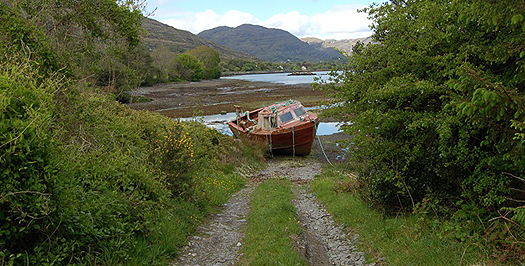
FISH IRELAND KILLYBEGS
These are tough times for the fishing industry and I have been hearing many stories of those difficulties at THE MARINE TIMES FISH IRELAND EXHIBITION in Killybegs. The problems are extensive – from limited quotas to the massive amount of regulations and it is not good to see fishing boats tied up at the quayside prevented from going to the fishing grounds by EU regulations. There are few industries where the official approach is to stop men from working. All this while foreign vessels continue to fish in Irish waters because their quotas are so much larger than those of Irish vessels. There is no doubt that politicians have made a complete mess of the fishing industry.
The small Irish fishing fleet could not have fished Irish waters to the low state of some stocks at present, but this fact is ignored by sensationalist commentaries in the general media where the facts of fishing and maritime life are not understood and there is insufficient expression of an opposite viewpoint. To see areas of Killybegs shuttered which should have viable fish-related industrial activities is disappointing and some of this is due to the attitude of Irish government officials who have frustrated development and stopped proposals which would have created jobs by imposition of unreasonable rents and regulations. It makes me wonder about the government's commitment to job creation.
There are other issues to be addressed, such as the differing reports from environmentalists, scientists, fishermen and leisure anglers about cod stocks. While environmentalists and scientists claim cod has disappeared from Irish waters, anglers report catching more than ever before and fishermen, who are controlled in catching them say the waters are alive with cod. So who is right – those who go out and see for themselves or land-based opinion?
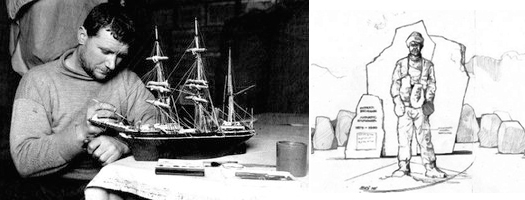
KEOHANE TO BE HONOURED IN COURTMAC
A project is underway in Courtmacsherry in West Cork, I am told, to honour the role of local man Patrick Keohane in Arctic exploration. He was one of those who located the bodies of Robert Falcon Scott and others from the Discovery Expedition of 1901-1904 near the South Pole. The location for a memorial to him is likely to be within view of his birthplace at Barry's Point on the route of the Seven Heads Walkway. A local committee is raising finance for the memorial. Unveiling day is likely to be Sunday, August 19. Well done to the people of Courtmacsherry.
This is an artist's impression of the sculpture.
ARCTIC
According to the Research Council of Norway the Arctic may contain more than a fifth of the Earth's undiscovered oil and gas. Increasing pressure on the region is indicated by shipping cargoes which will reach their highest level through the area this year as companies cut costs and fuel consumption by avoiding the Suez Canal. A thousand tonnes of fuel, costing over $600,000 dollars, can be saved. The environmental importance of the Arctic has been shown by the discovery of a 60-mile bloom of phytoplankton beneath the Chukchi Sea in the Arctic, regarded as "astonishing" by scientists. Phytoplantkon is the essential food of marine life.
WHERE IS IRISH AWARENESS?
Seafarers' Awareness Week, an annual campaign by the biggest charity helping seafarers in need – Seafarers UK – has just concluded. The charity works to raise awareness of Britain's dependence on seafarers and gives annual grants of more than stg£2 million to help seafarers, their families and dependants across the Merchant Navy, Fishing Fleets and the Royal Navy. What a pity there is not something similar in Ireland.
CONCORDIA CAPTAIN CHARGE WITH MANSLAUGHTER
Captain Francesco Schettino who commanded the cruise liner Costa Concordia is now charged with multiple manslaughter, causing the accident and abandoning ship prematurely. Italy's top appeals court has held that he should face the charges, indicating that he was unfit to command.
AMAZON NOW UNDER THREAT
Twenty-two hydro-electric schemes are planned to be built along the Amazon River and its tributaries. Environmentalists and indigenous rights campaigners claim this will alter the environmental and social balance and that the rain forest and tribes which live there will be permanently damaged as locals are removed to for construction work in remote areas. The power schemes are required to meet Brazil's burgeoning demand for electricity as the country develops economically.
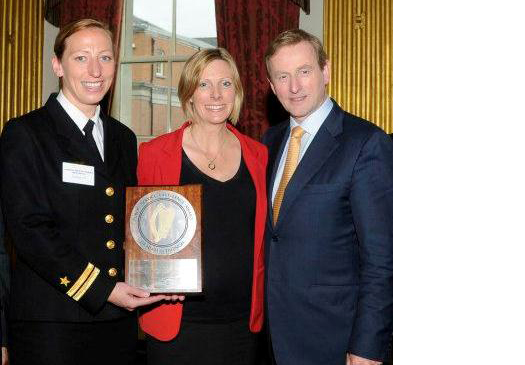
IMERC HONOURED BY TAOISEACH
I was delighted to see that IMERC, the Maritime and Energy Resource Cluster at the National Maritime College in Ringaskiddy, whose work I have praised previously, was awarded this year's "Public Service Excellence Award" by Taoiseach Enda Kenny.
The award highlights the opportunities for job creation and economic growth in the marine sector and the importance of realising the economic potential of Irish marine resources. IMERC was chosen from 190 projects. It is a tripartite alliance between the Naval Service, UCC and the Cork Institute of Technology Development. This is the first time a maritime project has featured in the awards since they were initiated in 2004.
Val Cummins directs the team which is developing the world's largest marine renewable energy research facility at Ringaskiddy. Congratulations to them on their well-deserved award.
Email your comments to THIS ISLAND NATION at [email protected]
Follow Tom MacSweeney on Twitter @TomMacSweeney and on Facebook – THIS ISLAND NATION
Round Ireland (Thurs 3pm). Can Inis Mor do it?
#roundireland – While the official tracker has Inis Mor as the overall leader in the 2012 Round Ireland Race, it's going to be a nail biting few hours for the French boat.
As of 3pm, Inis Mor has 30.6 miles to go. To beat Tonnerre she needs to cover that distance in five hours and 34 minutes. Simple math says she needs to average 5.49 knots and as she is making 5.7 knots just south of Lambay Island, it should work for her.
But, the 5.7 knots is not quite in the right direction – because the wind has headed her, she can only make 221° instead of the 190° she needs to reach Wicklow on one tack. So while 5.7 knots looks good, her actual progress towards the finish or VMG, is currently 5.4 knots – just outside the 5.49 knots needed.
To make matters worse, she is entering an area of stronger tides that will be directly against her for the last few hours into Wicklow. She can mitigate some of this by hugging the coast, but at what cost windwise?
Fascinating stuff, www.afloat.ie's money's on Tonnerre, at least in this battle. Keep an eye on Cavatina though – she still has a day left to win!
#roundireland – As predicted by www.afloat.ie it looks increasingly likely as if Piet Vroon's Ker 46 Tonnerre de Breskens 3 will follow in the footsteps of the legendary Moonduster, by winning successive Round Ireland Races.
While the final few miles are painfully wet, misty and slow, particularly on Green Dragon, it is likely that Tonnerre will cross the finishing line at the turn of the tide around 0730 this morning. This elapsed time of about 3 days 19 hours and 30 minutes will correct to 4 days 18 hours setting a tough target for the chasing pack.
DOWNLOAD THE PREDICTOR AS A PDF BELOW
Tonnerre, who struggled a bit at the top end of the North Channel, sailed a good race down the Irish Sea, maintaining pace with the much faster Green Dragon for a long period. Her standing was enhanced considerably by the bad luck of long time leader Inis Mor, who, along with Noonmark VI and Maxvmg Fortissimo, encountered strong adverse tides and a period of calm.
Not that it's all over yet, far from it. As the www.afloat.ie exclusive table shows (download attachment below as a pdf), there is still an opportunity for a number of boats to overtake Tonnerre. Inis Mor is the leading candidate, but Cavatina, Sgrech and NUI Galway all have an outside chance. To do so they will need a number of things –stronger wind, minimal distance and luck with the tides. Unfortunately, while they will enjoy freshening winds, it is the direction that is likely to kill off the challenge. Southerly forecasts mean it will be a noser for the rest of the way to Wicklow, forcing boats to beat to the finish, increasing the rhumb line distance.
So, with the battle continuing for the minor placings and class honours, it looks like another great success for Piet Vroon and his team, and possible heartbreak once again for Bernard Guoy and the Inis Mor crew. Whatever the outcome, 200 or so tired and hungry sailors will remember this one for a long time to come.
The www.afloat.ie exclusive predictor shows that Inis Mor, if she can maintain the average speed to date, can catch Tonnerre. All of the other boats have to improve on their average to date.
#roundireland – As the on-the-water leaders push down the north Irish Sea, the fleet can now be considered in four groups.
In group one, battling it out for line honours, is Green Dragon and Tonnerre and possible Lee Overlay Partners (not updating on the tracker), crossing tacks, in a southerly Force 4. Under present conditions a finish in the small hours of Thursday morning is expected.
DOWNLOAD OUR ROUND IRELAND PREDICTOR BELOW
Group two, on the Antrim coast, where the current corrected time leaders reside, consist of Inis Mor, Noonmark VI and, a bit further back, Maxvmg Fortissimo. This group has virtually no wind, but is not under huge threat from the similarly almost windless group three, spread from Instrahull to Aranmore.
Group four is a small group of backmarkers enjoying slightly better wind off the Mayo coast.
For those of us looking to predict a winner, the categorisation into groups allows us to consider the wind and tide effects on each group.
Of the first group, Tonnerre looks the most promising. She could finish early Thursday and post a time for the others to chase, which could turn into the winning result if the wind doesn't fill in for the chasing group.
Inis Mor has been the leader almost since the start of the race and is the most likely boat of the second group to feature on the poium. However, much will depend on the duration of the light winds in the North Channel and having to include an extra adverse tide in this section could prove very costly. Nooonmark VI has been featuring on the leaderboard and one tide could prove to be the separating factor from Inis Mor.
In the third group, the J-109s Jedi and Sgrech, the Reflex 38 NUI Galway and the J-105 Diablo J are the leading contenders to upset the current leaders, and don't rule out Cavatina making one of her charges for the rear.
Its all with the gods of the environment right now.
Assuming that Tonnerre finishes in Wicklow just after 4am on Thursday, the attached table speculates on leaderboard showing what each boat needs to do to match Tonerre's time.
Could it be a third time for Cavatina?
#roundireland – Inis Mor, Tonnerre and Noonmark VI are still podium boats as the fleet races across the North coast but the outcome of the next 24 hours may well decide the 2012 Round Ireland race.
While often the graveyard for Round Ireland success, the tide in the North Channel can not only be a boost to progress over the ground but can also boost a boat up the leaderboard. The trick is to have the luck to arrive at the east side of Rathlin close to Low Water Dover and ride the flood as far as the wind permits. If the stars align, the 68 mile passage to South Rock can be done in one tide and the lucky yacht will avoid adverse tides in the North part of the Irish Sea.
Unfortunately for Green Dragon and Tonerre, it looks like they are nearly 100% out of phase and are heading over towards the Mull of Kintyre to benefit from lesser tide on the Scottish side of the North Channel. The news isn't much better for the handicap leaders either, some 50 miles to the west, as with the lessening breeze they are down to less than three knots. At the moment it is looking good for the chasing pack some 80 miles further back, but making speeds in excess of 6 knots. But the pack looks sure to encounter the lighter winds before too long.
The variable factors and a fleet spread from Rathlin to Loop Head, render leaderboards and predictions extremely unreliable. Inis Mor, Tonnerre and Noonmark VI are still the podium boats at this stage and if they can get through the light patch, may be able to hang on until the finish in Wicklow, but notable movers behind are NUI Galway, Sgrech, Aquelina and, with a sense of inevitably, two time winner Cavatina.
The light airs will be creating extreme frustration amongst the leaders and with no major increase in wind speed in the future, thoughts of food rationing may well be entering the sailor's minds.
It's going to be an interesting 24 to 36 hours! Check back with afloat.ie during today for the very latest leaderboard news.
Meanwhile here's the estimated leaderboard at 20.30 last night (Tuesday) with corrected handicap time lapse on leaders shown in days: hours: minutes:
1 Inis Mor
2 Tonnerre de Breskens 3. 00 days: 00 hours: 46 minutes
3 Lee Overlay Partners 00:03:12
4 Noonmark VI 00:03:26
5 NUI Galway 00:10:00
6 Maxvmg Fortissimo 00:10:30
7 Sgrech 00:10:56
8 Spirit of Jacana 00:11:00
9 Diablo-j 00:11:01
10 Fastrak VIII 00:11:37
11 Jedi 00:11:45
12 Visit Malta Puma 00:11:50
13 Joker 2 00:12:01
14 Fujitsu 00:12:46
15 Aquelina 00:13:30
16 LC Tyres Lulabelle 00:13:31
17 IOSS- Desert Star 00:13:46
18 Pyxis 00:13:47
19 Cavatina 00:14:07
20 Wild Spirit 00:14:42
21 Twister 00:14:53
22 Persistance 00:14:57
23 Exhale 00:17:10
24 Cracklin' Rosie 00:17:20
25 EOS 00:17:33
26 Adelie 00:18:05
27 Midnight Mojito 00:18:22
28 Nunatak 00:19:11
29 Lancasrtian 00:20:11
30 Legally Blonde 00:20:26
31 Green Dragon 00:20:31
32 Pink Panter 00:22:47
33 Team Wild Goose 00:23:23
34 English Mick 01:03:14
35 Sarnia 01:05:48
36 Ocean Tango 01:09:55
Look Up! Volvo Ocean Race Trophy to Drop Out of Galway Sky
#VOR – Six of the world's fastest sailing boats will race from Lorient to Galway next week to compete the final dramatic leg of the 39,000 nautical mile round the world Volvo Ocean Race; the trophy they have battled across the globe to get their hands on will make an equally dramatic arrival in Galway.
The striking blue and silver Volvo Ocean Race trophy - which weighs 9 kilos and stands 70cms high - will drop from the skies during a spectacular parachute display to be staged by the Air Corp's Black Knights parachute team.
The five member team, carrying the flags of the ten countries that have participated in the race, will parachute from an Augusta Westland AW 139 helicopter to a to a waterfront landing zone close to the Global Village in South Park at 5pm on Thursday July 5th.
The national flags will be will be displayed in formation on the beach as the helicopter lands to deliver the trophy to Volvo Ocean Race CEO, Knud Frostad and John Killeen, President of the local organisers "Let's do it Global" in the presence of Taoiseach Enda Kenny.
Macnas drummers will add a dash of Galway street carnival atmosphere to the occasion.
As with the Olympic Games there is no financial reward for winning the Volvo round the world race and the beautifully designed trophy has been created to symbolize the glory of winning what is still one of the most extreme challenges in the world of sport.
According to the world's most famous yachtsmen and women just competing in the race represents an achievement with success meaning everything to those who have achieved it.
Mike Sanderson, skipper of ABN AMBRO ONE the winner of the 2005-06 race said after crossing the line in Gothenburg " This is my Olympic Gold, my Mount Everest, my childhood dream"
The Volvo Trophy will be handed to Knud Frostad by a member of the helicopter flight team . It comprises of 11 wave shaped rings - each ring representing one of the 11 races held so far. The 11th ring will be engraved when the boat which finally claim victory in the 2011-2012 race takes podium honours in Galway.
And the eventual winner of the gruelling round the world race will now be decided in the seas off the Irish west coast or perhaps in Galway Bay with four of the six participating boats still separated by just a handful of points.
The French entry Groupama, the current race favourite, is on 219 points, but only has a 23 point lead on the US challenger Puma on 196, New Zealand's "Camper" is on 191 with Spain's "Telefonica" also on 191 points. The other two boats Abu Dhabi Ocean Racing is on 122 and the Chinese entry, Sanya, which is being part sponsored by Failte Ireland, is on 39.
The second last in port race will take place in Lorient on Saturday and the fleet then set out on the final 485 nautical dash to Galway battling for the vital 30 points a leg win carries. The Lorient in port race and the Galway in port race both carry 6 points
Race followers will have an opportunity to see another air display at Salthill as the final in port race takes place On Saturday July 7th. The race begins at 11am and is due to finish about 4pm. The air display is scheduled for 2.45pm weather permitting.
It will involve formation and solo flights by four Air Corp Pilatus PC-9M aircraft and by an Augusta Westland AW 139 helicopter that will take part in a maritime display and a winching operation in conjunction with the naval vessel L.E. Niamh. A number of coastguard helicopters are also expected to join in the display.



























